|
In the decades following World War II, an independently minded and critically engaged form of photography began to gather momentum. Its practitioners have combined their skills as artists and reporters, creating extended photographic essays that delve deeply into topics of social concern and present distinct personal visions of the world.
Engaged Observers looks in depth at projects by a selection of the most vital photographers who have contributed to the development of this approach. Passionately committed to their subjects, they have authored evocative bodies of work that are often published extensively as books and transcend the realm of traditional photojournalism.
|
 |
 |
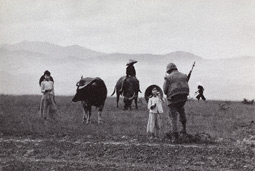
 |
 |
Vietnam, Philip Jones Griffiths, 1967
© The Philip Jones Griffiths Foundation / Magnum Photos
|
 |
 |
|
Philip Jones Griffiths described the scene he photographed in this image:
"Limits of friendship. A Marine introduces a peasant girl to king-sized filter-tips. Of all the U.S. forces in Vietnam, it was the Marines that approached 'Civic Action' with gusto. From their barrage of handouts, one discovers that, in the month of January 1967 alone, they gave away to the Vietnamese 101,535 pounds of food, 4,810 pounds of soap, 14,662 books and magazines, 106 pounds of candy, 1,215 toys, and 1 midwifery kit. In the same month they gave the Vietnamese 530 free haircuts."
Vietnam Inc., Philip Jones Griffiths' 1971 critical account of America's armed intervention in Southeast Asia, is one of the most detailed photographic stories of a war published by a single photographer. The project's exploration of the war's failures and its focus on civilians made it a particularly engaging and ambitious work of advocacy journalism. Griffiths put the conflict in the context of Vietnam's history and culture, showing how Capitalist values that America promoted in its efforts to contain the spread of Communism were out of sync with Vietnam's communal and agrarian way of life.
|
 |
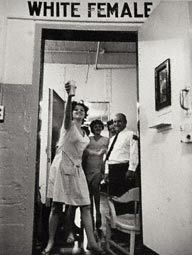
 |
 |
New Orleans, Leonard Freed, 1965
© Leonard Freed / Magnum Photos
|
 |
 |
|
|
 |
While in Germany in 1962, Leonard Freed saw a black American soldier guarding the divide between East and West Berlin. He was haunted by the idea of a man standing in defense of a country in which his own rights were in question. The experience ignited Freed's interest in the American civil rights movement. In June 1963 he embarked on a multiyear documentary project, published in about 1968 as Black in White America, which would become the signature work of his career.
The series is a visual diary with a moralizing purpose. Freed quickly found that his interests lay in exploring the diverse, everyday lives of a community that had been marginalized for so long. Penetrating the fabric of daily existence, his work portrays the common humanity of a people persevering in unjust circumstances. This empathetic approach sought not to stimulate outrage but to foster understanding and bridge cultural divides as a way of transcending racial antipathy.
|
 |
 |
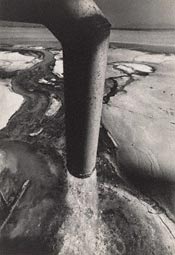
 |
 |
Industrial Waste from the Chisso Chemical Company, W. Eugene Smith, 1972
Collection of H. Christopher Luce. Courtesy of Robert Mann Gallery. Minamata photographs by W. Eugene Smith & Aileen M. Smith - © Aileen Smith
|
 |
 |
|
In 1971 W. Eugene and Aileen M. Smith were told of a controversy over industrial pollution in the Japanese fishing village of Minamata. Beginning in the 1950s, thousands of people were severely affected by mercury poisoning, brought about by eating fish contaminated with chemical waste dumped in the bay by the Chisso Corporation. The ailment, which became known as Minamata Disease, caused irreversible brain damage, paralysis, and convulsions.
The couple set out to document the progress of a lawsuit against the company, recording the course of the trial through the court's ruling in favor of the plaintiffs in 1973. Their essay relates the importance of the sea and fishing to the town's culture, reports on the company's drainage pipes into the sea, chronicles lives transformed by the disease, and depicts the demonstrations that took place in opposition to Chisso. The work resulted in numerous magazine publications, exhibitions, and a book, Minamata, published in 1975. The project gained traction within the political atmosphere of the 1970s, when the environmental movement was taking off.
|
 |
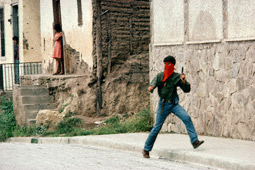
 |
 |
First day of popular insurrection, August 26, 1978, Matagalpa, Nicaragua, Susan Meiselas, negative, August 26, 1978; print, 1980s
© Susan Meiselas / Magnum Photos
|
 |
 |
|
|
 |
In 1978 Susan Meiselas traveled to Nicaragua where she witnessed the eruption of a full-scale revolution against the country's repressive, hard-line government. Meiselas was taken by the bravery of those willing to risk their lives against the dictatorship for the promise of a better future. The record of her movements around the country formed a narrative about the insurrection's progress. Meiselas made a decision—at the time, unusual in serious war reportage—to record the revolution on color film, because it seemed appropriate for capturing the vibrancy and optimism of the resistance.
The pictures were picked up by newspapers and magazines around the world, giving individual images a public life, but without Meiselas's control with regard to captioning, and fragmented from her larger body of pictures. In her book, published in 1981 as Nicaragua, June 1978–July 1979, Meiselas reasserted the narrative of the revolution as she experienced it and gave greater permanence and coherence to her documentary endeavor.
|
 |
 |
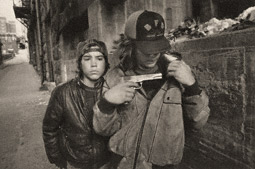
 |
 |
"Rat" and Mike with a Gun, Seattle, Mary Ellen Mark, 1983
© Mary Ellen Mark
|
 |
 |
|
Mary Ellen Mark has reported on the state of our social environment for more than four decades. In 1983 she traveled to Seattle to do an article for Life magazine on runaway children. She built trust with the community of runaways living in the downtown area, and created pictures that show teenagers who survived on tough streets through petty crime, prostitution, foraging in dumpsters, and panhandling. Mark's compositions are striking and uncomfortable, emphasizing her subjects' youth while capturing them engaged in activities beyond their years.
After publishing the article in Life, Mark continued to develop the story as both a documentary film and still photography book with her husband, filmmaker Martin Bell, and reporter Cheryl McCall. The Streetwise project gave individuality and visibility to the problem of runaway children and called for greater social and political commitment to addressing America's epidemic of broken families.
|
 |
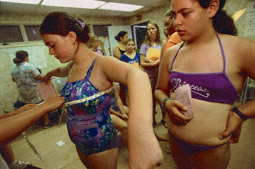
 |
 |
Danielle, 13, gets measured as Michelle, 13, waits for the final weigh in on the last day of weight loss camp, Catskills, New York. From the series Girl Culture. Lauren Greenfield, negative, 2001; print, 2002
© Lauren Greenfield/INSTITUTE
|
 |
 |
|
|
 |
Photographer and documentary filmmaker Lauren Greenfield has built her reputation as a chronicler of mainstream American culture. In 2002 she published Girl Culture, a photographic project that delves into the ways consumer society affects the lives of women in America. Of central concern to Greenfield was the exhibitionist tendencies of contemporary American femininity.
Visiting girls of all ages at home, in doctors' offices, and out with friends, Greenfield examined personal issues of public consequence, providing an intense and intimate exploration of girls' relationships to their bodies and the effects of popular culture on self-image. Many of her pictures and accompanying interviews focus on what she calls "body projects," the daily grooming rituals undertaken to express identity through appearance. Others look at the social and consumerist influences from which these young women take their cues, and the difficulty of living up to such expectations.
|
 |
 |
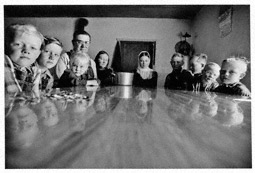
 |
 |
La Batea Colony, Zacatecas, Mexico, Larry Towell, negative, 1994; print, 1999
© Larry Towell / Magnum Photos
|
 |
 |
|
In 1989 Larry Towell came into contact with members of a Mennonite community (a Protestant sect related to the Amish) near his home in Canada. The Mennonites Towell befriended had migrated to Canada from Mexico in search of seasonal work. Due to shrinking water tables in Mexico, the effects of international trade, and a rising population in the colonies, many Mennonites have found themselves landless and economically marginalized, forced to compromise their beliefs in order to survive. Towell eventually joined them in their treks back to Mexico for the winter and spent 10 years photographing their activities. He had unique access to capture their struggle to preserve a lifestyle incongruent with the world they depend upon.
Towell's work documented the Mennonites' way of life for the historical record and inspires greater understanding for a group who could be easily overlooked. In spending a decade on a subject of only passing interest to mainstream media, he asserts a form of visual reporting in which reflection takes precedence over profitability and immediacy.
|
 |
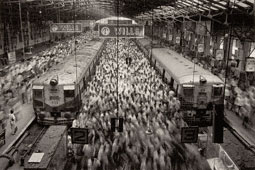
 |
 |
Church Gate Station, Western Railroad Line, Bombay, India, Sebastião Salgado, negative, 1995; print, 2009
© Sebastião Salgado
|
 |
 |
Trained in economics before taking up photography, Sebastião Salgado has used his camera to raise awareness of the world's economic disparities and provoke discussion about the state of our international social environment. Between 1994 and 1999 Salgado pursued an enormous project to document migrant populations around the world. Published in 2000 as Migrations: Humanity in Transition, this epic work documents people across 43 countries who have been uprooted by globalization, persecution, or war.
Salgado's work is marked by an aesthetic grace that endows his subjects with dignity even as it communicates the discomfort of their circumstances. His photographs are constructed with careful attention to dramatic lighting, elegant contours, and striking visual impact. Ultimately, Salgado sees himself as a storyteller and a communicator, a bridge between the fortunate and the unfortunate, the developed and the undeveloped, the stable and the uprooted.
|
 |
 |
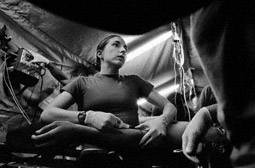
 |
 |
The Sacrifice (detail), James Nachtwey, negatives, 2006–7; print, 2010
Courtesy of and © James Nachtwey
|
 |
James Nachtwey has dedicated himself to delivering an antiwar message by documenting those around the world affected by conflict. In 2006 he traveled with emergency medical units in Iraq for a photo essay, The Sacrifice, that depicts helicopter transfers from battle sites to treatment centers, emergency rooms where lives hang in the balance, and the difficult process of recovery.
In anticipation of exhibiting the series, Nachtwey created a monumental installation print of 60 individual trauma-center images, tightly framed and digitally collaged into a grid. The object's sheer size—in which one picture gives way to the next in a seemingly endless stream of torn flesh, metal instruments, snaking tubes, and bloodied hands—conveys a sense of the controlled chaos that permeates these medical centers as well as the overwhelming volume of casualties flowing through the medics' hands on a daily basis.
Nachtwey's intentionally unsettling work demands that we reconcile the goals and achievements of armed conflict with its human costs, that we be prepared to acknowledge in particular visual terms the sacrifice it entails and the valiant work of those who do their best to mend its path of destruction.
|
 |